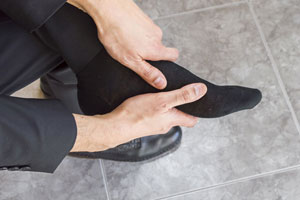A big pain in the heel
Plantar fasciitis is an inflammation of the broad ligament that spans the bottom of the foot and attaches to the under surface of the heel. Runners often get plantar fasciitis because of repetitive trauma that creates microtears in the ligament. The condition can occur as a result of a change of routine, an increase in distance or shoes that are worn out and no longer support the arch of the foot.
Athletes who make fast starts and stops — such as baseball and basketball players — are at risk. But the problem also can develop as a result of excessive standing or walking — particularly on hard surfaces.
The onset is usually gradual and the pain is nearly always worse when the foot first hits the floor in the morning or upon standing after a long period of sitting. This is because the fibers have contracted during inactivity and shriek with pain when they are suddenly stretched. Pain then usually subsides, to return later, toward the end of the day or when you’re tired from exertion.
As with injuries elsewhere in the body, the inflammation is an effort by the body to repair itself. But the location on the bottom of the heel makes healing very difficult. With virtually every move, the tears are re-opened and the healing process starts all over. Professional athletes find the injury particularly troublesome because the injury doesn’t seem significant enough to be sidelined; yet with every day action the injured fibers never have enough time to heal.
Treatment
- Rest. Change to an activity pattern that puts less strain on the ligament. A rowing machine or an exercise bike will do less damage, for example, than running or walking.
- Ice and anti-inflammatory medications also help ease the pain.
- Stretching and strengthening routines are recommended to help correct factors such as tightness in the calf and Achilles tendon and weakness of the foot muscles. Stretches that might help include wall pushups, stair stretches or standing on a slanted board. Rolling the foot over a 15-ounce can or a tennis ball also can help.
- Shoes with shock absorption and the correct arch support will help.
- Shoe inserts, either custom-molded or over-the-counter arch supports, can support the arch and change the mechanics of the foot to eliminate abnormalities that are causing increased stress on that part of the foot.
